Stakeholder Management Template
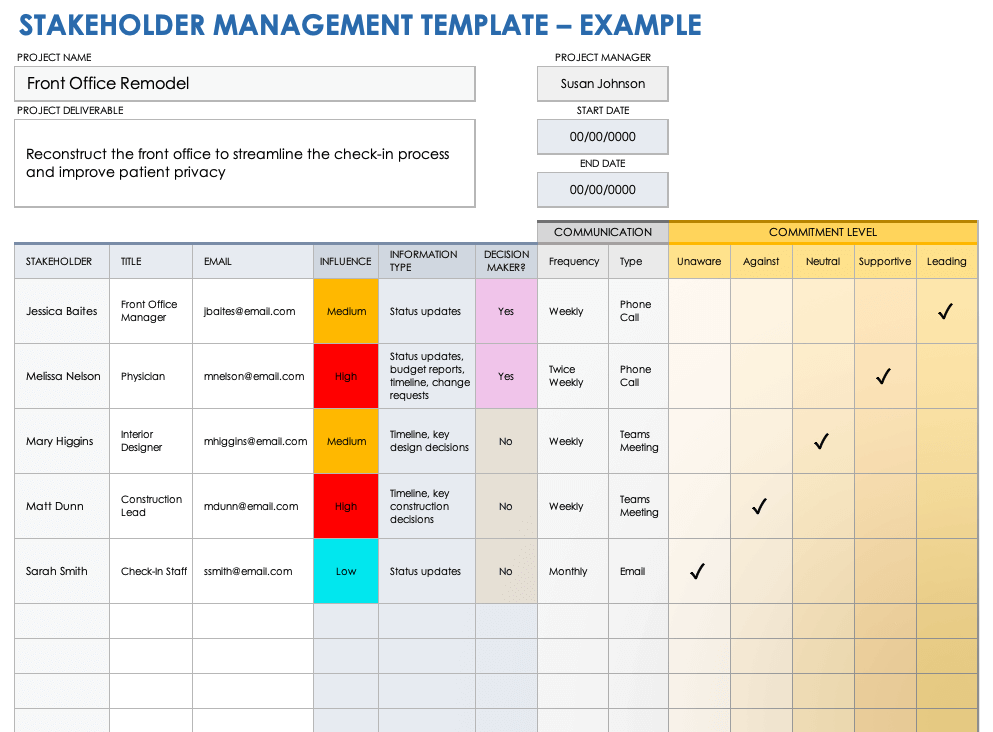
Download a Sample Stakeholder Management Template for
Excel
|
Microsoft Word
Download a Blank Stakeholder Management Template for
Excel
|
Microsoft Word
Strengthen your project’s strategic communication plan and improve transparency by using this stakeholder management template. Available in a blank, fillable version or with sample text, this tool allows you to list your stakeholders and their titles, as well as track communication methods and frequency. The template is organized into three sections (one for basic information, one for information about the project, and one for the level of each stakeholder’s commitment), making it easy to plug in all the key pieces of stakeholder information.
Learn how to create stakeholder management and communication plans.
Stakeholder Update Excel Template With Matrix
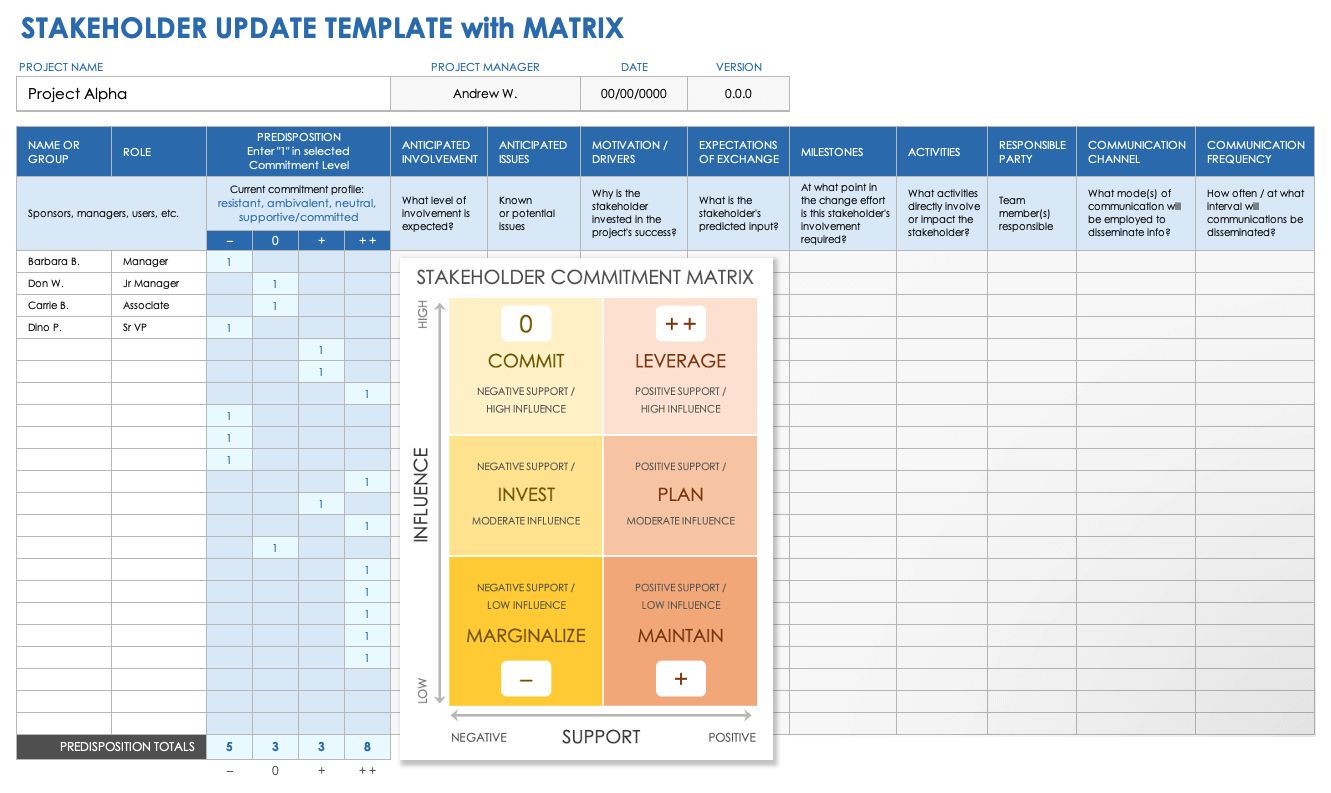
Download the Stakeholder Update Template With Matrix for
Use this stakeholder update template with a matrix to build an analysis for engaging project stakeholders. The customizable spreadsheet provides space for stakeholder information, including anticipated involvement, motivation, and drivers. This tool gives you the power to visually represent each stakeholder’s influence and support.
Basic Stakeholder Engagement Plan Template
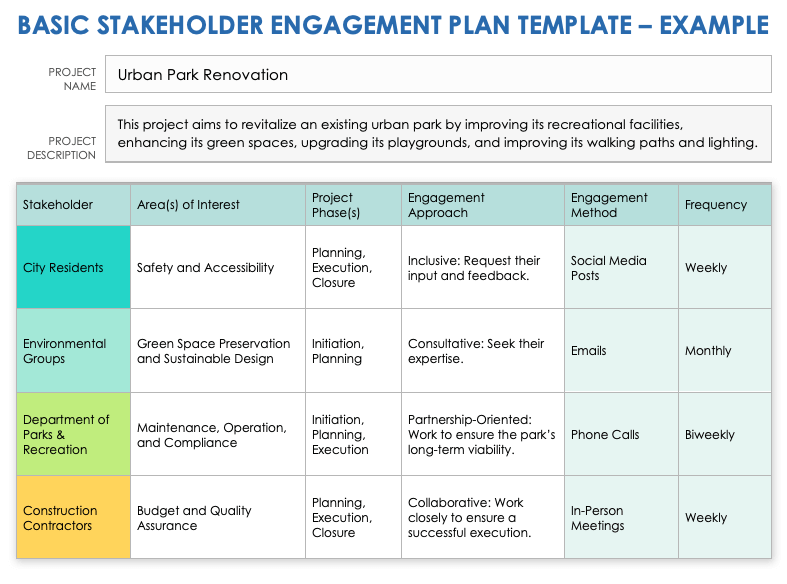
Download a Sample Basic Stakeholder Engagement Plan Template for
Excel
|
Microsoft Word
|
Adobe PDF
|
PowerPoint
Download a Blank Basic Stakeholder Engagement Plan Template for
Excel
|
Microsoft Word
|
Adobe PDF
|
PowerPoint
Use this basic stakeholder engagement plan template to list your stakeholders, detail their roles in a project, and determine the communication channels your team will use to engage them. This template is available as a blank table or with example text. The table format makes it easy to locate specific information, including which engagement approach to use for a specific stakeholder and how often to communicate with them regarding your project.
Strategic Engagement Plan Template
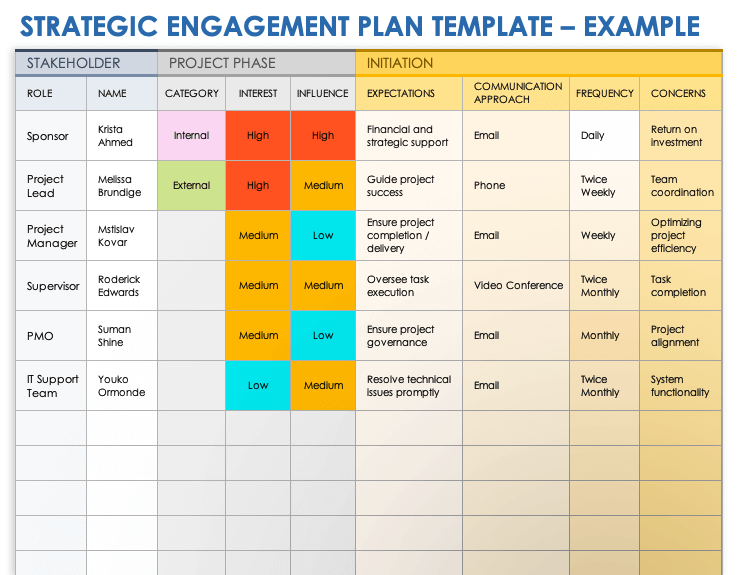
Download a Sample Strategic Engagement Plan Template for
Excel
|
Microsoft Word
|
Adobe PDF
|
PowerPoint
Download a Blank Strategic Engagement Plan Template for
Excel
|
Microsoft Word
|
Adobe PDF
|
PowerPoint
Use this strategic engagement plan template for a detailed communication strategy that includes each stakeholder’s expectations and concerns. This tool is available in two versions: a blank version and one with sample text. The Initiation section promotes the transparency of each stakeholder’s needs and brings attention to areas that you must address before such issues disrupt a project’s scope. Enter all your stakeholders and project phases to build a comprehensive plan.
Stakeholder Engagement Assessment Matrix
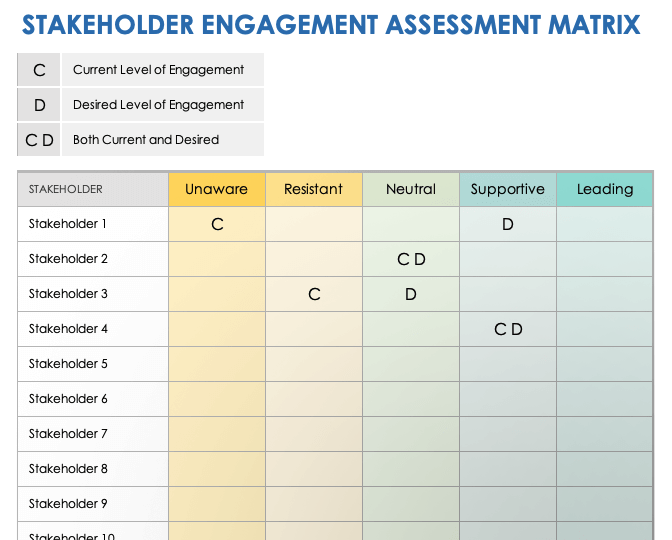
Download a Stakeholder Engagement Assessment Matrix for
Excel
|
Microsoft Word
|
Adobe PDF
|
PowerPoint
A stakeholder engagement assessment matrix is a tool you use to document each stakeholder’s current and ideal level of involvement. Complete the matrix before your project begins. Then use the matrix data to manage stakeholder engagement throughout your project’s lifecycle.
What Is a Stakeholder Engagement Plan?
A stakeholder engagement plan (SEP) is a document that supplements your project plan for the purpose of identifying internal and external stakeholders and outlining a communication strategy that engages them effectively.
The plan includes the frequency of communication, the communication platforms, and the type of information you are going to share based on each stakeholder’s influence and area(s) of interest.
Elements in a Stakeholder Engagement Plan
An effective stakeholder engagement plan requires the following key elements: each stakeholder’s name, role, degree of engagement, and level of influence, as well as the method and frequency for contacting each of them.
Include those elements under the following categories to ensure that each stakeholder receives the correct information at the appropriate time:
- Stakeholder Name: This section identifies each individual involved in a project or impacted by its outcome, such as an employee, a customer, a board member, or an investor. Learn about stakeholder theory and how it impacts an organization.
- Stakeholder Role: A stakeholder’s role can help determine their level of engagement and the type of information you share with them.
- Degree of Engagement: This is how actively involved or interested a stakeholder is in a project.
- Influence Level: This is the level of power a stakeholder has over project decisions.
- Communication Method: The communication method indicates how you will communicate with a stakeholder.
- Communication Frequency: The communication frequency indicates how often you will communicate with a stakeholder.
How to Create a Stakeholder Engagement Plan
A stakeholder engagement plan is essential for any project because it determines who will receive project information, how they will receive it, and how often. Use the following step-by-step guide to create a stakeholder engagement plan.
- Identify Your Project’s Stakeholders
Identify the individuals involved in a project and impacted by its outcome. Add internal stakeholders (such as board members) and external stakeholders (such as investors). In some cases, the process of identifying your stakeholders will be obvious; in other cases, you might have to ask managers or other stakeholders about whom to include.To learn more about stakeholders and how to support their needs, check out these free stakeholder analysis templates. - Collect Each Stakeholder’s Contact Information
You need stakeholder contact information for communication purposes, whether you’re sending a project update or a meeting invite. - Determine Each Stakeholder’s Influence Level
The Project Management Institute states that “influence indicates a stakeholder’s relative power over and within a project” and is based on the individual’s hierarchical, economic, social, or political position, as well as their expert knowledge and skills in negotiation and building consensus. Note the influence level of each stakeholder in your plan as high, medium, or low.
To help you gauge each stakeholder’s level of influence, check out these free stakeholder mapping templates. - Determine Each Stakeholder’s Engagement Level
For each stakeholder, note if they are neutral, supportive, resistant, leading, or unaware. A stakeholder’s engagement level often depends on their personal or financial commitment to the success of a project. - Determine Each Stakeholder’s Interests
Determine the type and amount of information to share with each stakeholder. For example, a customer does not need to know budget details, whereas an investor requires this information. - Determine Communication Method
Determine how you will communicate with each stakeholder: via emails, face-to-face meetings, phone calls, or chat tools such as Slack and Microsoft Teams. The method will vary for each stakeholder depending on their preference and the project manager’s needs. - Determine Communication Frequency
Determine how often you will communicate with each stakeholder: on a daily, weekly, monthly, or other basis. Not all stakeholders require the same frequency. You will likely communicate more often with stakeholders who have a high degree of engagement. - Download the stakeholder engagement plan template.
How to Use a Stakeholder Engagement Plan
Create your stakeholder engagement plan during the project planning phase to establish the groundwork for communicating with and including all key contributors. Reference the plan regularly in order to update it with any necessary changes.
Benefits of Using a Stakeholder Engagement Plan
There are several benefits to using a stakeholder engagement plan. At a high level, it establishes a framework for addressing a stakeholder’s communication requirements concerning a project.
Here are the additional benefits of a stakeholder plan:
- Collaboration: Partnering with stakeholders during your project builds trust and strengthens relationships.
- Effective Communication: Information is structured and easy to understand.
- Efficiency: Project managers and team members know what to do and when.
- Expectation Management: Stakeholder expectations are aligned with a project’s scope, objectives, and deliverables.
- Risk Mitigation: The risk of miscommunicating, forgetting to relay certain information, or leaving out an important stakeholder are much lower when you use a stakeholder engagement plan.
- Transparent Decision-Making: Communication methods are straightforward for project managers, stakeholders, and team members.
- Useful Resource: All of your stakeholder engagement information is located in one central place. You can reference such information during the current project or use it as a resource for future projects.
Perfect Your Project Management With Stakeholder Engagement Plan Templates from Smartsheet
From simple task management and project planning to complex resource and portfolio management, Smartsheet helps you improve collaboration and increase work velocity -- empowering you to get more done.
The Smartsheet platform makes it easy to plan, capture, manage, and report on work from anywhere, helping your team be more effective and get more done. Report on key metrics and get real-time visibility into work as it happens with roll-up reports, dashboards, and automated workflows built to keep your team connected and informed.
When teams have clarity into the work getting done, there’s no telling how much more they can accomplish in the same amount of time. Try Smartsheet for free, today.